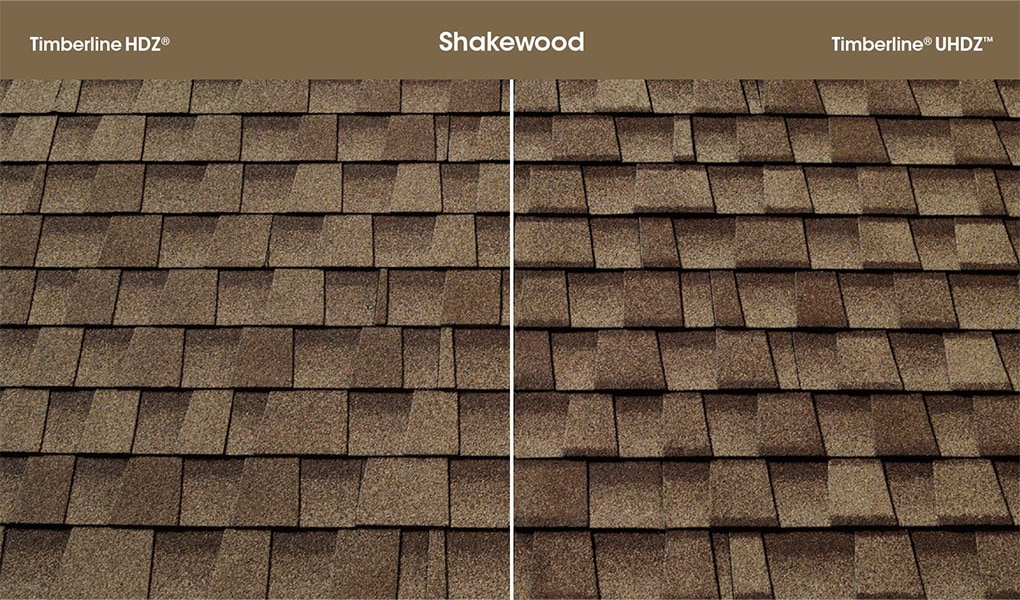GAF recently launched a premium version of their bestselling Timberline HDZ® Shingles—Timberline UHDZ® Shingles. A reengineered version of GAF Timberline® UHD—Ultra High Definition—Shingles, these have all the features that have made Timberline HDZ® Shingles a popular choice for homeowners, but with a few extras—ranging from enhanced aesthetics to 10% Time-Release Algae-Fighting Technology. Here's an at-a-glance comparison of the benefits of both shingles to help you choose the best fit for the project and budget you're working with.
Curb Appeal
Both Timberline® UHDZ™ and Timberline HDZ® Shingles provide a stylish wood-shake look, for beautiful curb appeal that can help boost the value of a home. The difference with the new Ultra High Definition™ Shingles is, as their name suggests, their patent-pending Dual Shadow Line feature—which provides an ultra-dimensional, deeply defined look via a "sunset shadow effect" that's perceptible all day long. Timberline® UHDZ™ Shingles are also thicker, which adds to their enhanced dimensionality.

Cost
Timberline HDZ® Shingles remain more affordable than their premium counterpart, making them a high-quality choice that's cost-effective. However, the extra features that come with Timberline UHDZ® could be well worth the slightly higher price that customers may be happy to pay if they understand the difference between the two products.
Warranty
Warranties are a good way to offer customers peace of mind, assuring them they'll be covered in certain circumstances. The advanced technologies incorporated into both Timberline® HDZ® and Timberline UHDZ™ Shingles allow GAF to offer a 15-Year WindProven™ Limited Wind Warranty* on these shingles if they're installed along with the required combination of four qualifying GAF accessories. Unusually, this warranty has no maximum wind speed limitation.
GAF Timberline® UHDZ™ Shingles also come with a 30-year StainGuard Plus Pro Limited Warranty against blue-green algae discoloration** as they feature 10% more GAF Time-Release Algae-Fighting Technology (capsules infused with copper microsites that release copper steadily over time) than Timberline HDZ® Shingles. That said, Timberline HDZ® Shingles come with a 25-year StainGuard Plus Limited Warranty against blue-green algae discoloration***—still extremely competitive. More information on both algae-protection limited warranty options can be found here.
Design
Both shingle types are available in an attractive range of colors, with the Timberline HDZ® line offering color blends and finishes like Charcoal, Birchwood, Hunter Green, and White. A full list of colors is included on the Timberline HDZ® product page.
Meanwhile, Timberline UHDZ® Shingles come in Pewter Gray, Charcoal, Barkwood, Slate, Weathered Wood, and Shakewood. While the color schemes are similar, Timberline HDZ® shingles currently have the edge on choice with a few more available options.
Installation
Both the Timberline HDZ® and UHDZ® Shingles come with LayerLock® Technology, which makes for easier and faster installation. Both products feature the StrikeZone® Nailing Area, helping your crews place the nails in the correct spot each time. So, no matter whether you use Timberline HDZ® or Timberline UHDZ® shingles, installation will likely be smooth-running.
Finding the Right Choice for Your Needs
Ultimately, the property owner will decide the shingle style and color—but armed with this information, contractors can provide clients with more options and allow them to make the optimal choice for their roof. Your expertise will be needed to explain the differences between Timberline HDZ® and Timberline UHDZ® Shingles, so it's important to understand the finer points of each.
Interested in learning more about these products? Explore the Timberline UHDZ® Shingle and Timberline HDZ® Shingle product pages, or reach out to your local Territory Manager for additional information. You can even get a preview of how they'd look on your home using the GAF Virtual Home Remodeler.
*15-year WindProven™ limited wind warranty on GAF Shingles with LayerLock™ Technology requires the use of GAF Starter Strips, Roof Deck Protection, Ridge Cap Shingles, and Leak Barrier or Attic Ventilation. See GAF Roofing System Limited Warranty for complete coverage and restrictions. Visit gaf.com/LRS for qualifying GAF products. For installations not eligible for the WindProven limited wind warranty, see GAF Shingle & Accessory Limited Warranty for complete coverage and restrictions.
**25-year StainGuard Plus™ Algae Protection Limited Warranty against blue-green algae discoloration is available only on products sold in packages bearing the StainGuard Plus™ logo. See GAF Shingle & Accessory Limited Warranty for complete coverage and restrictions and qualifying products.
*** 30-year StainGuard Plus PRO™ Algae Protection Limited Warranty against blue-green algae discoloration is available only on products sold in packages bearing the StainGuard Plus PRO™ logo. See GAF Shingle & Accessory Limited Warranty for complete coverage and restrictions.

